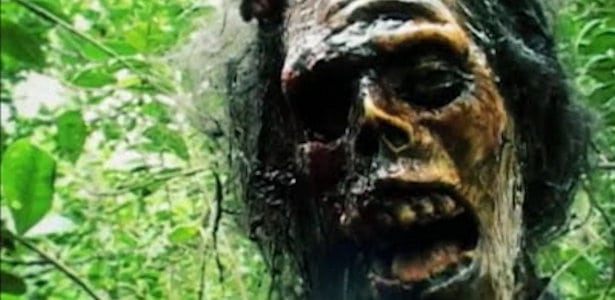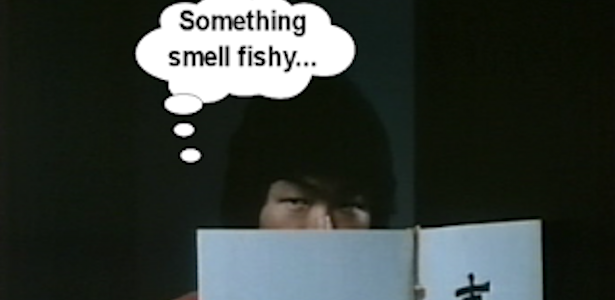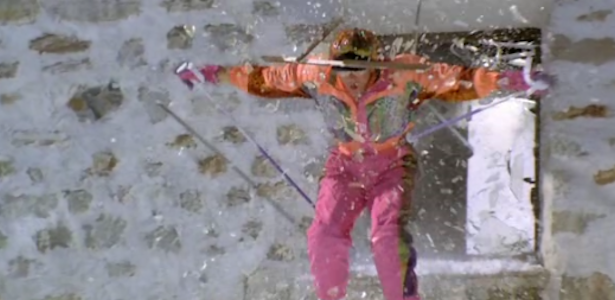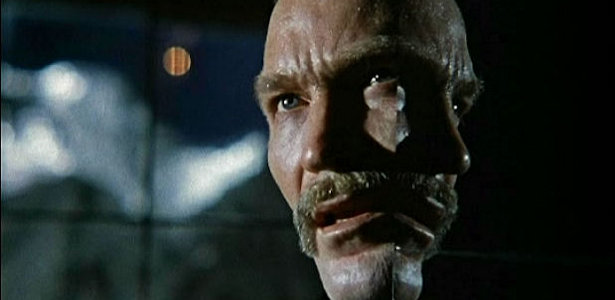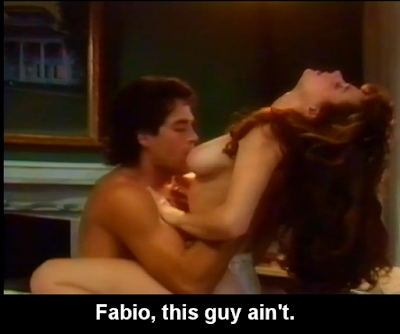Over the last several decades the foreign knock-offs of Hollywood films have been almost an industry unto itself. In the late '70s and '80s we got a deluge of films that were inspired by Hollywood hits, but many were only that: "inspired by". Lucio Fulci's celebrated gorefest ZOMBI 2 (aka ZOMBIE, 1979) was intended by the producers to be a loose sequel to George Romero's undead classic DAWN OF THE DEAD (aka ZOMBI, 1978). Of course, as we all know, the only thing the producers really cared about was being able to advertise it as a sequel and left Fulci to do whatever the hell he wanted. It was great for the producers who cashed in on the title, it was great for Fulci who got to make a throwback to old school zombie movies (albeit with a staggering amount of gore for the time) and it was great for us, the anti-social deviants, who got to see something gruesomely spectacular that set trends in cinema that continue to this day. The trend of rip-offs have become even bigger in scope with major Hollywood studios using a film's built-in name recognition to sell a new film. Of course, now we euphemistically call them "reboots".
 THE EXORCIST (1973) was one of the biggest, earliest Hollywood hits that inspired imitations around the globe. In spite of the fact that William Freidkin and William Peter Blatty's vision was not intended as a horror film, it was so intense that not only did it make a lasting impression on viewers, it became widely circulated in the press that the movie could literally cause mental illness in normally stable individuals. Several psychiatrists wrote papers on, not only the presumed effect of seeing the movie, but published actual case notes regarding the treatment of individuals who have been driven to varying degrees of madness by the film. One such paper established that the media coverage on television alone was enough to cause a 24 year-old father to be unable to sleep, develop a suspicion of strangers, experience sympathetic neck stiffness (from Regan's head-turn) and experienced undue stress that his 5 year-old daughter might actually be possessed. Having seen some pretty disturbing behavior out of children in public places these days, I wouldn't completely rule out that out. This was, or rather still is, referred to as "Cinematic Neurosis," which what I intend to name my first child. More discussion of this phenomenon can be found in this vintage 20 minute made-for-television documentary.
THE EXORCIST (1973) was one of the biggest, earliest Hollywood hits that inspired imitations around the globe. In spite of the fact that William Freidkin and William Peter Blatty's vision was not intended as a horror film, it was so intense that not only did it make a lasting impression on viewers, it became widely circulated in the press that the movie could literally cause mental illness in normally stable individuals. Several psychiatrists wrote papers on, not only the presumed effect of seeing the movie, but published actual case notes regarding the treatment of individuals who have been driven to varying degrees of madness by the film. One such paper established that the media coverage on television alone was enough to cause a 24 year-old father to be unable to sleep, develop a suspicion of strangers, experience sympathetic neck stiffness (from Regan's head-turn) and experienced undue stress that his 5 year-old daughter might actually be possessed. Having seen some pretty disturbing behavior out of children in public places these days, I wouldn't completely rule out that out. This was, or rather still is, referred to as "Cinematic Neurosis," which what I intend to name my first child. More discussion of this phenomenon can be found in this vintage 20 minute made-for-television documentary.
 It is this sort of quasi-quackery along with claims that it was based on the documented 1949 case of Robbie Mannheim ("Roland Doe"), that illustrates just what kind of cultural impression the movie had in 1973. The monument of the impact was partially due to the fact that a mere five years earlier in 1968, the extremely conservative Hays Code was dismantled in favor of a similar version of the current rating system that we have today. The ratings system gave a lot more leeway in terms of sex, violence and "adult themes". While there were plenty of horror movies in the '60s, a majority of them were either aimed at children, or were micro-budget affairs that were carried around the country in the back of the filmmaker's car. THE EXORCIST was a big budgeted film (for the time), weighing in at $65 million in today's dollars. This was a sharp contrast to a majority of horror films that were being made for thousands of dollars. The film was a deadly serious speculation on the dark side of religion in a time where people were starting to move away from the church. With beautiful cinematography, a hauntingly memorable score, an excellent cast and Dick Smith's groundbreaking effects, it became the highest grossing film of all time, and still one of the highest horror films, until it was dethroned by JAWS two short years later. It is also the first horror film nominated for an Oscar (10 nods in all), with Blatty taking one home. Barring ROSEMARY'S BABY (1968), it was arguably the advent of the big studio exploitation pictures that have evolved to completely dominate American theatrical releases. It was an event that will never again be repeated in cinema. Naturally, since it was such a big pie, everyone wanted a slice. Preferably with extra cheese.
It is this sort of quasi-quackery along with claims that it was based on the documented 1949 case of Robbie Mannheim ("Roland Doe"), that illustrates just what kind of cultural impression the movie had in 1973. The monument of the impact was partially due to the fact that a mere five years earlier in 1968, the extremely conservative Hays Code was dismantled in favor of a similar version of the current rating system that we have today. The ratings system gave a lot more leeway in terms of sex, violence and "adult themes". While there were plenty of horror movies in the '60s, a majority of them were either aimed at children, or were micro-budget affairs that were carried around the country in the back of the filmmaker's car. THE EXORCIST was a big budgeted film (for the time), weighing in at $65 million in today's dollars. This was a sharp contrast to a majority of horror films that were being made for thousands of dollars. The film was a deadly serious speculation on the dark side of religion in a time where people were starting to move away from the church. With beautiful cinematography, a hauntingly memorable score, an excellent cast and Dick Smith's groundbreaking effects, it became the highest grossing film of all time, and still one of the highest horror films, until it was dethroned by JAWS two short years later. It is also the first horror film nominated for an Oscar (10 nods in all), with Blatty taking one home. Barring ROSEMARY'S BABY (1968), it was arguably the advent of the big studio exploitation pictures that have evolved to completely dominate American theatrical releases. It was an event that will never again be repeated in cinema. Naturally, since it was such a big pie, everyone wanted a slice. Preferably with extra cheese.
For some reason the Italians saw this film as a springboard to sexually sleazy films frequently featured a demon possessing a nubile girl who would develop a bad attitude and an extreme aversion to clothing, such as Franco Lo Cascio and Angelo Pannacciò's CRIES AND SHADOWS (aka EXORCIST III, 1975). Italy also used concepts from THE EXORCIST and ROSEMARY'S BABY (1968) as a springboard to utterly strange, almost surreal films like Ovidio G. Assonitis' BEYOND THE DOOR (1974). Spain was in the game with the fan favorite, Amando de Ossorio's THE POSSESSED (aka DEMON WITCH CHILD, 1975). There are many other interesting ripple effects through global cinema as well, but then there is Turkey.
I'm sure by now we are all familiar with Turkish cinema of the '70s and '80s. Heavily influenced by Hollywood, but unlike the Italians who are obsessed with artistic expression even when making no-budget knock-offs, the Turks are pretty blatant in their liberties. Almost like Hollywood does now, the Turks would shoot a literal remake of the film in question, except with a minuscule budget that often relied on stealing special effects footage and musical scores from other films.
Sometimes these remakes offer up an engaging alternate version, such as the DEATH WISH (1974) remake EXECUTIONER (aka CELLAT, 1975), which still features an architect with some serious family drama, but allows it to play out in a way that doesn't feel like a shot-for-shot remake. On the other end of the spectrum we have SEYTAN. Turkey's quick and dirty EXORCIST clone that makes absolutely no bones about remaking the original almost scene for scene.
An old priest (Agah Hün) in a padre cordobes hat finds what appears to be a high-school talent show project in the middle of an archaeological dig in the desert, though unlike THE EXORCIST, the archaeological dig is basically a couple of guys digging in sand.
In short order we meet Ayten (Meral Taygun), a single mother who lives in an upscale two story house with a conveniently long staircase leading up to it. While she plays a lot of tennis, like all white Americans do, her pre-teen daughter Gul (Canan Perver), who apparently spends most of her time in bed, has been playing with a new game that allows her to communicate with the spirit world. The game is basically a Ouija board that looks handmade, but not in artisanal way. Kevin Tenney would spin in his grave. Well, he would if he were dead, anyway. Of course when mom wants to play the game, nothing happens, which Gul cheerfully explains is because "Captain Lersen" (who?) wouldn't like it.
Hearing weird noises in the attic that sound vaguely like frozen plumbing but are suggested by the cook to be mice, Ayten investigates and conveniently finds a book titled (deep breath) "Seytan: Soul Abduction and Exorcism Ceremony Under the Light of the Modern Opinions about Mental Illness." The book is written by the Father Karras substitute, Tugrul Bilge (Cihan Ünal), a med school drop-out who is writing faith-based supernatural non-fiction about stuff that he doesn't have any belief in. Pity the fool who gets cornered by that guy at a party. Oh and his mother is losing it and is locked in a mental asylum. Not to miss out on any clinical moment Gul is taken to a doctor who says he wants to perform cranial surgery in order to "clean the wound on her brain." Unfortunately for the doctor, the x-rays show nothing wrong. For some reason I feel like I've seen this before.
Sort of like a cover band butchering all the classics, SEYTAN is happy to simply rehash many memorable scenes from the original, some of them verbatim. There is a potential boyfriend, Ekrem (Ekrem Gökkaya), who ends up pretending to be the baby carriage in BATTLESHIP POTEMKIN (1925), just as the character Burke Dennings did in the original. We have a scene where Regan - err, I mean Gul walks down the stairs during a party and pees green gunk all over her feet. There is a scene where Gul's top is up and we see "help me" written (in Turkish) on her stomach in what appears to be street make-up. Of course there is the head-turning sequence, but since there is no Turkish Dick Smith, it is done simply by having the actress moving her head inside a false body. There is also a police inspector, originally played by Lee J. Cobb, who is convinced that Ekrem's death was not a freak accident, but of course he doesn't have a shred of proof, nor does he really have much to do with the movie other than show up once or twice, smoke some cigarettes, ask a few questions and exit stage left. If you felt like it, you could criticize THE EXORCIST of reducing the part down to an almost inconsequential figure, from the character in Blatty's novel. Even so, it's clearly a part included in SEYTAN in order to ape the original. Even the scene where Ellen Burstyn's character is hysterically trying to get through to her ex-husband in Rome on the phone is recreated, though it could have easily been tossed out or replaced with something else.
SEYTAN is almost a proto Jan Debont exercise, shuffling around a few story elements, but largely keeping the movie a condensed version of the original made on a budget so minuscule that it would cause Al Adamson to throw his hands up in despair. Even the theme is a re-edit of Mike Oldfield's iconic work, though this should surprise absolutely no one. Directed by Metin Erksan, who made films in Turkey in a six decade long career since the mid '50s, apparently felt that artistic expression doesn't put the kebab on the table. This is particularly ironic as Erksan, who passed away in 2012, was also, and I'm not making this up, a formally educated art historian. Yep, the guy who pounded out this ultra-cheap and blatant ripoff not only knew his art, but was once an award-winning director who specialized in character dramas that detailed the hardships of life in Turkey. That must have been one expensive swimming pool.
 As mentioned, there are a few places where writer Yilmaz Tumturk, who has apparently only written five films, stumbles off the path into his own special place of virtual parody. One of the best bits where Tumturk attempts to recreate the original, is a scene where a pretentious hypnotist tries to put Gul under in order to find out why she's acting like Donald Trump on a cocaine and mescal bender. After fussing around with a crystal on a chain, he contacts Captain Lersen and is rewarded with a sharp punch in the "tubular bells". Not content with the original's gruesome crucifix scene, here Gul is in bed not with a crucifix - I'm guessing a largely Muslim audience is not going to be able to relate to that - but a letter opener with a demonic face! Violently masturbating with a cross may be incredibly subversive, but the letter opener is a pretty nasty image. In a similar note, when the old man in the hat shows up to exorcise the demon, instead of holy water, he shakes some "zamzam water" on her! The horror. Actually it's just Islam's version of holy water taken from the Zamzam Well in Mecca. Thanks for ruining my fun with facts Google.
As mentioned, there are a few places where writer Yilmaz Tumturk, who has apparently only written five films, stumbles off the path into his own special place of virtual parody. One of the best bits where Tumturk attempts to recreate the original, is a scene where a pretentious hypnotist tries to put Gul under in order to find out why she's acting like Donald Trump on a cocaine and mescal bender. After fussing around with a crystal on a chain, he contacts Captain Lersen and is rewarded with a sharp punch in the "tubular bells". Not content with the original's gruesome crucifix scene, here Gul is in bed not with a crucifix - I'm guessing a largely Muslim audience is not going to be able to relate to that - but a letter opener with a demonic face! Violently masturbating with a cross may be incredibly subversive, but the letter opener is a pretty nasty image. In a similar note, when the old man in the hat shows up to exorcise the demon, instead of holy water, he shakes some "zamzam water" on her! The horror. Actually it's just Islam's version of holy water taken from the Zamzam Well in Mecca. Thanks for ruining my fun with facts Google.
Amusingly the IMDb states that SEYTAN is a "version" of William Girdler's EXORCIST knock-off ABBY (1974). Both released in the same year, Girdler's black cast film filches plenty of moments from Friedkin's classic, but manages to make plenty of deviations as well. For one, the main character is an adult female marriage counselor instead of a privileged white child allowing for crazy scenes in places like a disco. Honestly when you think "demonic possession", who doesn't think "disco"? Girdler's film, like many other films that capitalized on the unmitigated success of THE EXORCIST, doesn't feel the need to follow the original step by step and is all the better for it. If SEYTAN had gone to crazy town a bit more often and relied less on coloring between the lines, it could have been a cult classic in the truest sense of the phrase. I feel kind of bad comparing a multi-million dollar, iconic Hollywood film to a poverty-stricken foreign remake, but as it stands, it is a pretty weak facsimile of the original with a few fun moments.
 THE EXORCIST (1973) was one of the biggest, earliest Hollywood hits that inspired imitations around the globe. In spite of the fact that William Freidkin and William Peter Blatty's vision was not intended as a horror film, it was so intense that not only did it make a lasting impression on viewers, it became widely circulated in the press that the movie could literally cause mental illness in normally stable individuals. Several psychiatrists wrote papers on, not only the presumed effect of seeing the movie, but published actual case notes regarding the treatment of individuals who have been driven to varying degrees of madness by the film. One such paper established that the media coverage on television alone was enough to cause a 24 year-old father to be unable to sleep, develop a suspicion of strangers, experience sympathetic neck stiffness (from Regan's head-turn) and experienced undue stress that his 5 year-old daughter might actually be possessed. Having seen some pretty disturbing behavior out of children in public places these days, I wouldn't completely rule out that out. This was, or rather still is, referred to as "Cinematic Neurosis," which what I intend to name my first child. More discussion of this phenomenon can be found in this vintage 20 minute made-for-television documentary.
THE EXORCIST (1973) was one of the biggest, earliest Hollywood hits that inspired imitations around the globe. In spite of the fact that William Freidkin and William Peter Blatty's vision was not intended as a horror film, it was so intense that not only did it make a lasting impression on viewers, it became widely circulated in the press that the movie could literally cause mental illness in normally stable individuals. Several psychiatrists wrote papers on, not only the presumed effect of seeing the movie, but published actual case notes regarding the treatment of individuals who have been driven to varying degrees of madness by the film. One such paper established that the media coverage on television alone was enough to cause a 24 year-old father to be unable to sleep, develop a suspicion of strangers, experience sympathetic neck stiffness (from Regan's head-turn) and experienced undue stress that his 5 year-old daughter might actually be possessed. Having seen some pretty disturbing behavior out of children in public places these days, I wouldn't completely rule out that out. This was, or rather still is, referred to as "Cinematic Neurosis," which what I intend to name my first child. More discussion of this phenomenon can be found in this vintage 20 minute made-for-television documentary. It is this sort of quasi-quackery along with claims that it was based on the documented 1949 case of Robbie Mannheim ("Roland Doe"), that illustrates just what kind of cultural impression the movie had in 1973. The monument of the impact was partially due to the fact that a mere five years earlier in 1968, the extremely conservative Hays Code was dismantled in favor of a similar version of the current rating system that we have today. The ratings system gave a lot more leeway in terms of sex, violence and "adult themes". While there were plenty of horror movies in the '60s, a majority of them were either aimed at children, or were micro-budget affairs that were carried around the country in the back of the filmmaker's car. THE EXORCIST was a big budgeted film (for the time), weighing in at $65 million in today's dollars. This was a sharp contrast to a majority of horror films that were being made for thousands of dollars. The film was a deadly serious speculation on the dark side of religion in a time where people were starting to move away from the church. With beautiful cinematography, a hauntingly memorable score, an excellent cast and Dick Smith's groundbreaking effects, it became the highest grossing film of all time, and still one of the highest horror films, until it was dethroned by JAWS two short years later. It is also the first horror film nominated for an Oscar (10 nods in all), with Blatty taking one home. Barring ROSEMARY'S BABY (1968), it was arguably the advent of the big studio exploitation pictures that have evolved to completely dominate American theatrical releases. It was an event that will never again be repeated in cinema. Naturally, since it was such a big pie, everyone wanted a slice. Preferably with extra cheese.
It is this sort of quasi-quackery along with claims that it was based on the documented 1949 case of Robbie Mannheim ("Roland Doe"), that illustrates just what kind of cultural impression the movie had in 1973. The monument of the impact was partially due to the fact that a mere five years earlier in 1968, the extremely conservative Hays Code was dismantled in favor of a similar version of the current rating system that we have today. The ratings system gave a lot more leeway in terms of sex, violence and "adult themes". While there were plenty of horror movies in the '60s, a majority of them were either aimed at children, or were micro-budget affairs that were carried around the country in the back of the filmmaker's car. THE EXORCIST was a big budgeted film (for the time), weighing in at $65 million in today's dollars. This was a sharp contrast to a majority of horror films that were being made for thousands of dollars. The film was a deadly serious speculation on the dark side of religion in a time where people were starting to move away from the church. With beautiful cinematography, a hauntingly memorable score, an excellent cast and Dick Smith's groundbreaking effects, it became the highest grossing film of all time, and still one of the highest horror films, until it was dethroned by JAWS two short years later. It is also the first horror film nominated for an Oscar (10 nods in all), with Blatty taking one home. Barring ROSEMARY'S BABY (1968), it was arguably the advent of the big studio exploitation pictures that have evolved to completely dominate American theatrical releases. It was an event that will never again be repeated in cinema. Naturally, since it was such a big pie, everyone wanted a slice. Preferably with extra cheese.For some reason the Italians saw this film as a springboard to sexually sleazy films frequently featured a demon possessing a nubile girl who would develop a bad attitude and an extreme aversion to clothing, such as Franco Lo Cascio and Angelo Pannacciò's CRIES AND SHADOWS (aka EXORCIST III, 1975). Italy also used concepts from THE EXORCIST and ROSEMARY'S BABY (1968) as a springboard to utterly strange, almost surreal films like Ovidio G. Assonitis' BEYOND THE DOOR (1974). Spain was in the game with the fan favorite, Amando de Ossorio's THE POSSESSED (aka DEMON WITCH CHILD, 1975). There are many other interesting ripple effects through global cinema as well, but then there is Turkey.
Sometimes these remakes offer up an engaging alternate version, such as the DEATH WISH (1974) remake EXECUTIONER (aka CELLAT, 1975), which still features an architect with some serious family drama, but allows it to play out in a way that doesn't feel like a shot-for-shot remake. On the other end of the spectrum we have SEYTAN. Turkey's quick and dirty EXORCIST clone that makes absolutely no bones about remaking the original almost scene for scene.
In short order we meet Ayten (Meral Taygun), a single mother who lives in an upscale two story house with a conveniently long staircase leading up to it. While she plays a lot of tennis, like all white Americans do, her pre-teen daughter Gul (Canan Perver), who apparently spends most of her time in bed, has been playing with a new game that allows her to communicate with the spirit world. The game is basically a Ouija board that looks handmade, but not in artisanal way. Kevin Tenney would spin in his grave. Well, he would if he were dead, anyway. Of course when mom wants to play the game, nothing happens, which Gul cheerfully explains is because "Captain Lersen" (who?) wouldn't like it.
Sort of like a cover band butchering all the classics, SEYTAN is happy to simply rehash many memorable scenes from the original, some of them verbatim. There is a potential boyfriend, Ekrem (Ekrem Gökkaya), who ends up pretending to be the baby carriage in BATTLESHIP POTEMKIN (1925), just as the character Burke Dennings did in the original. We have a scene where Regan - err, I mean Gul walks down the stairs during a party and pees green gunk all over her feet. There is a scene where Gul's top is up and we see "help me" written (in Turkish) on her stomach in what appears to be street make-up. Of course there is the head-turning sequence, but since there is no Turkish Dick Smith, it is done simply by having the actress moving her head inside a false body. There is also a police inspector, originally played by Lee J. Cobb, who is convinced that Ekrem's death was not a freak accident, but of course he doesn't have a shred of proof, nor does he really have much to do with the movie other than show up once or twice, smoke some cigarettes, ask a few questions and exit stage left. If you felt like it, you could criticize THE EXORCIST of reducing the part down to an almost inconsequential figure, from the character in Blatty's novel. Even so, it's clearly a part included in SEYTAN in order to ape the original. Even the scene where Ellen Burstyn's character is hysterically trying to get through to her ex-husband in Rome on the phone is recreated, though it could have easily been tossed out or replaced with something else.
SEYTAN is almost a proto Jan Debont exercise, shuffling around a few story elements, but largely keeping the movie a condensed version of the original made on a budget so minuscule that it would cause Al Adamson to throw his hands up in despair. Even the theme is a re-edit of Mike Oldfield's iconic work, though this should surprise absolutely no one. Directed by Metin Erksan, who made films in Turkey in a six decade long career since the mid '50s, apparently felt that artistic expression doesn't put the kebab on the table. This is particularly ironic as Erksan, who passed away in 2012, was also, and I'm not making this up, a formally educated art historian. Yep, the guy who pounded out this ultra-cheap and blatant ripoff not only knew his art, but was once an award-winning director who specialized in character dramas that detailed the hardships of life in Turkey. That must have been one expensive swimming pool.
 As mentioned, there are a few places where writer Yilmaz Tumturk, who has apparently only written five films, stumbles off the path into his own special place of virtual parody. One of the best bits where Tumturk attempts to recreate the original, is a scene where a pretentious hypnotist tries to put Gul under in order to find out why she's acting like Donald Trump on a cocaine and mescal bender. After fussing around with a crystal on a chain, he contacts Captain Lersen and is rewarded with a sharp punch in the "tubular bells". Not content with the original's gruesome crucifix scene, here Gul is in bed not with a crucifix - I'm guessing a largely Muslim audience is not going to be able to relate to that - but a letter opener with a demonic face! Violently masturbating with a cross may be incredibly subversive, but the letter opener is a pretty nasty image. In a similar note, when the old man in the hat shows up to exorcise the demon, instead of holy water, he shakes some "zamzam water" on her! The horror. Actually it's just Islam's version of holy water taken from the Zamzam Well in Mecca. Thanks for ruining my fun with facts Google.
As mentioned, there are a few places where writer Yilmaz Tumturk, who has apparently only written five films, stumbles off the path into his own special place of virtual parody. One of the best bits where Tumturk attempts to recreate the original, is a scene where a pretentious hypnotist tries to put Gul under in order to find out why she's acting like Donald Trump on a cocaine and mescal bender. After fussing around with a crystal on a chain, he contacts Captain Lersen and is rewarded with a sharp punch in the "tubular bells". Not content with the original's gruesome crucifix scene, here Gul is in bed not with a crucifix - I'm guessing a largely Muslim audience is not going to be able to relate to that - but a letter opener with a demonic face! Violently masturbating with a cross may be incredibly subversive, but the letter opener is a pretty nasty image. In a similar note, when the old man in the hat shows up to exorcise the demon, instead of holy water, he shakes some "zamzam water" on her! The horror. Actually it's just Islam's version of holy water taken from the Zamzam Well in Mecca. Thanks for ruining my fun with facts Google.Amusingly the IMDb states that SEYTAN is a "version" of William Girdler's EXORCIST knock-off ABBY (1974). Both released in the same year, Girdler's black cast film filches plenty of moments from Friedkin's classic, but manages to make plenty of deviations as well. For one, the main character is an adult female marriage counselor instead of a privileged white child allowing for crazy scenes in places like a disco. Honestly when you think "demonic possession", who doesn't think "disco"? Girdler's film, like many other films that capitalized on the unmitigated success of THE EXORCIST, doesn't feel the need to follow the original step by step and is all the better for it. If SEYTAN had gone to crazy town a bit more often and relied less on coloring between the lines, it could have been a cult classic in the truest sense of the phrase. I feel kind of bad comparing a multi-million dollar, iconic Hollywood film to a poverty-stricken foreign remake, but as it stands, it is a pretty weak facsimile of the original with a few fun moments.





